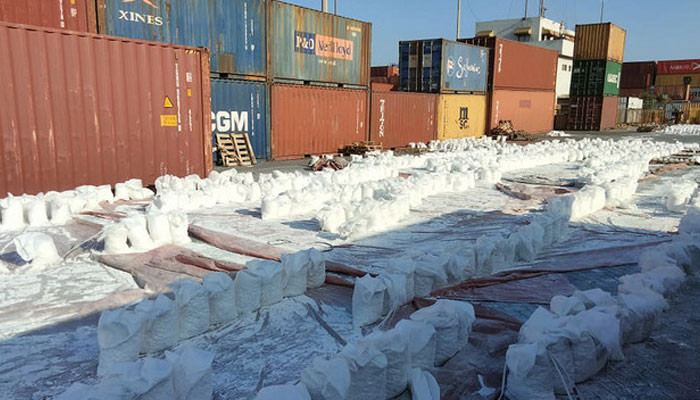Pakistan’s Unintentional Role in the International Drug Trade
Pakistan’s location has historically positioned it as a hub for global commerce. Regrettably, the nation is now involuntarily caught up in the pervasive global drug trade.
Sharing borders with both Afghanistan and Iran, Pakistan is frequently, but inaccurately, portrayed as a primary origin of narcotics, despite actually being a victim of the illegal substances that transit through its territory.
The seriousness of this issue requires due acknowledgment of Pakistan’s consistent efforts against drug trafficking, the significant difficulties it encounters, and the steadfast determination demonstrated by the Anti-Narcotics Force (ANF) and other law enforcement bodies in their struggle against this global problem.
The worldwide economic framework of illicit drug trafficking operates on the principle of supply and demand, with Afghanistan serving as the primary source of heroin, responsible for approximately 90% of global production.
Data from the United Nations Office on Drugs and Crime (UNODC) indicates that approximately 40% of Afghan-produced heroin is transported through Pakistan en route to lucrative markets within the Gulf Cooperation Council (GCC) countries, Europe, and other regions.
The 2,640 km long, easily crossed border with Afghanistan, along with a 1,046 km coastline, provides smugglers with numerous access points, turning enforcement into a constant battle against these illicit networks.
While Pakistan is often seen as merely a transit point for narcotics, it is important to recognize that the country is not the intended primary consumer. However, its use as a transit route brings significant adverse effects. Pakistan faces an increasing number of addiction cases. A 2013 survey indicated that around 6.7 million Pakistanis are affected by substance use disorders, primarily among the younger population.
This crisis, caused by international drug trafficking networks, disrupts societal structures and places substantial burden on public health resources and law enforcement capabilities. As a frontline state, Pakistan combats a problem it did not create, yet it endures the related socio-economic burdens and security risks associated with the international drug trade.
Efforts by the Anti-Narcotics Force (ANF)
The Anti-Narcotics Force (ANF) leads Pakistan’s counter-narcotics strategy. In 2024, the ANF intercepted and seized over 176 metric tons of illegal drugs, valued at $10 billion on the international market. The ANF’s work includes high-risk interdiction operations at border crossings, airports, and seaports, where traffickers continuously adapt their methods to avoid security measures.
In addition to seizures, the ANF has increased its partnerships with the Gulf Cooperation Council (GCC) countries and international law enforcement agencies (LEAs) such as the DEA (USA), NCA (UK), and CTF-151 (Multi-nation Naval Task Force) to improve intelligence sharing and disrupt smuggling operations before shipments reach their destinations. Recent joint operations with authorities in Saudi Arabia and the UAE have successfully dismantled numerous transnational trafficking networks.
Evolving Tactics of Traffickers
A growing issue is the utilization of courier services for transporting narcotics, due to the continuous evolution of concealment methods and tactics. Drug traffickers are increasingly using international logistics networks to circumvent traditional security measures by concealing narcotics within parcels disguised as legal goods and accompanied by falsified documents.
In the past year, the ANF intercepted more than 200 drug shipments linked to courier services, highlighting the necessity for enhanced screening procedures and stronger collaboration between law enforcement agencies and private sector service providers.
The challenge extends beyond physical interdiction; the digitalisation of illegal transactions and the utilization of the dark web for narcotics trade further complicate enforcement efforts, demanding the integration of sophisticated technologies and data-driven intelligence operations.
Societal Impact and the Way Forward
The effects of drug trafficking extend well beyond law enforcement.
Pakistan’s youth, who represent 64% of the population, are particularly vulnerable, as drug trafficking fuels a dangerous cycle of addiction, crime, and social decline. Annually, thousands of young Pakistanis become dependent on drugs, leading to devastated lives, diminished productivity, and an increase in drug-related crimes.
Combating the drug threat is not only a matter of security but also a crucial step to protect the nation’s future. Advocacy campaigns, community-based educational programs, and specialized rehabilitation services are essential for preventing young individuals from succumbing to addiction and reintegrating recovering individuals back into society.
The battle against drug smuggling needs a cohesive global strategy, as no single nation can fight it alone. The GCC countries and other key international partners must acknowledge Pakistan’s position as a frontline state and provide substantial diplomatic and operational support to improve its efforts to combat narcotics and their trafficking.
Enhancing maritime patrols, investing in border security technology, strengthening legal structures, and formalizing intelligence-sharing mechanisms are essential collaborative actions needed to halt the flow of drug trafficking. Without such coordinated efforts, traffickers will continue exploiting vulnerabilities, prolonging a crisis that jeopardizes both regional and global stability.
Pakistan’s continuous fight against narcotics smuggling is not just a domestic matter but a crucial component of broader international efforts against the drug trade.
Despite economic pressures and rising security concerns, Pakistan remains dedicated to dismantling Drug Trafficking Organizations (DTOs) and safeguarding future generations from the dangers of drug addiction. International players must collaborate to eliminate the billion-dollar illicit drug economy. Through sustained collaboration, intelligence sharing, and strategic enforcement, progress can be made against this global threat, ensuring a more secure future for everyone.



Comments (0)
No comments yet. Be the first to comment!
Leave a Comment